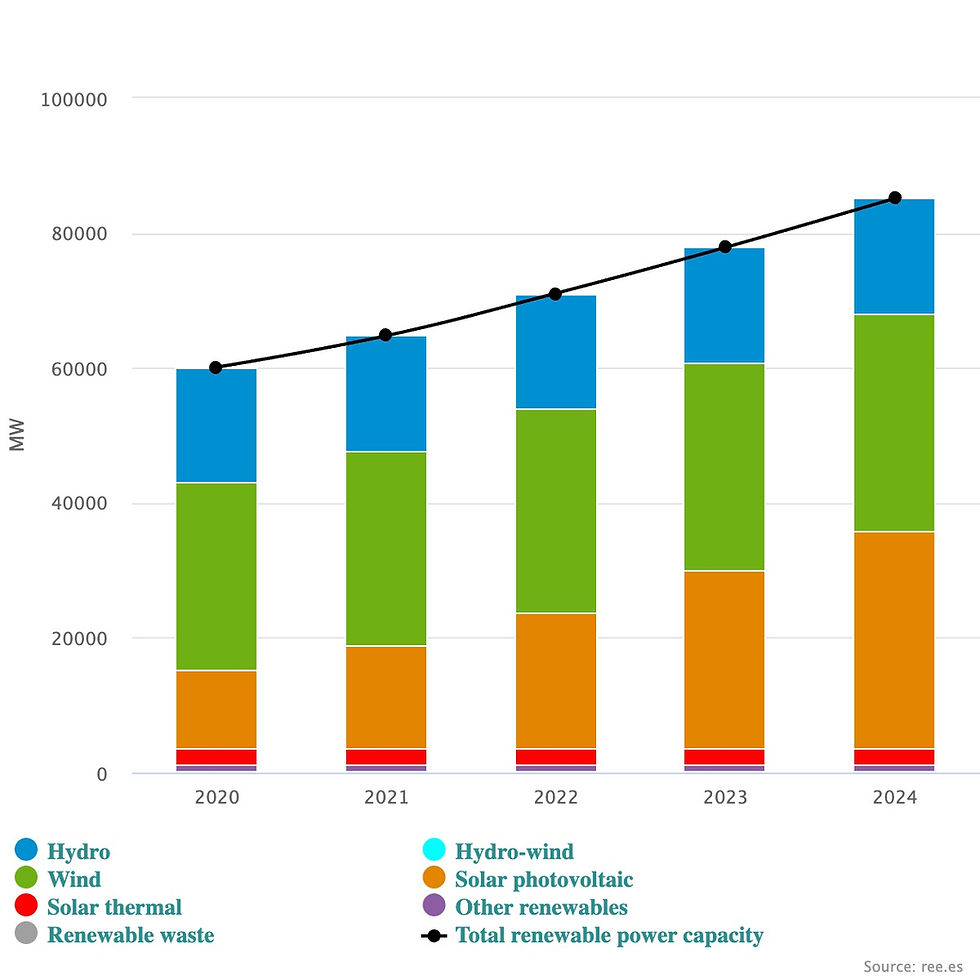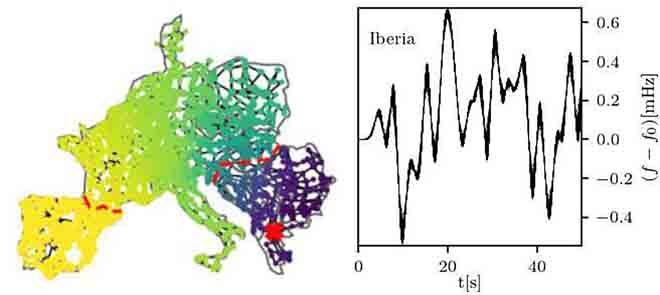Why the Lights Went Out in Spain
- David Dodge

- Jun 15
- 7 min read
Experts Analyze 'Sudden' Loss of 15 Gigawatts of Power

On April 28, 2025, a catastrophic electricity blackout left 60 million people in Spain and Portugal without power when 15 gigawatts vanished from the grid in seconds.
The cascading outage affected businesses, transportation, and many other sectors for 12 to 14 hours.
The pundits weighed in quickly, blaming such things as renewable energy usage, atmospheric vibrations, frequency oscillations across Europe, a lack of grid inertia, failure of control systems, and a plethora of other factors.

So, Were Renewables to Blame?
“Great question,” says Michael Liebreich, an investor, advisor, and the founder of Bloomberg New Energy Finance, in an interview with The Earth & I.
Twenty years ago, Spain had about 18% renewables in its energy mix. This has shot up to 56% as of today.
And ironically, just a few weeks before the blackout, fans of renewable energy were celebrating that Spain had generated 100% of its electricity from renewables during one day.

“And then, of course, two weeks later, you had the power cut. And the finger is pointed at renewables because wind and solar don’t provide what are called grid stability services,” says Liebreich. In order to meet electricity demand, “you have to do some very specific things to manage the voltage, to manage the frequency, and deal with all sorts of harmonics and artifacts across this incredibly complex system.”
To get the grid back on, “black start” capability—which is essentially having power to run the stuff that generates the electricity—is needed. This can be provided by diesel generators or batteries, but wind and solar cannot provide this service, Liebreich says.
And to be clear, he adds, “This system is incredibly complex, and we don’t know the official version of what happened. We reached out to Spanish officials, and they were not ready to comment on the cause of this, which is under investigation and will take some time to sort out. What the European grid is trying to do is to keep the same frequency across the whole thing, all the way from the Baltic republics down to the edge of Portugal and, of course, down into the Balkans as well.”

Frequency Needs to Be in Tune
The North American grid operates at 60 hertz, while the European grid operates at 50 hertz, and “all of [Spain’s] equipment is designed to work at that frequency,” says Liebreich. He likens the situation to a car’s speed control, where the driver sets the cruise control to the 60-mph limit and “if it fluctuates between 59 and 60, you won’t get a ticket.”
But if the cruise control is out of whack and varies between 65 and 75, the driver might get a ticket.
On the grid, inertia stops that from happening. “Generally, big spinning resources stop it from speeding up and slowing down and [keep] the voltage [from] wandering all over the place,” he says.
Grid services such as short-circuit current and black-start capability help keep things from changing too fast. Services like reactive power help control the rate of change of frequency, also known as ROCOF.
Strange Things Happened Pre-Blackout
Prior to the blackout, there were weird artifacts, harmonics, and bouncing frequencies. For example, physicist Philippe Jacquod noticed these oscillations against Latvia’s grid.
Prior to the blackout, there were weird artifacts, harmonics, and bouncing frequencies.
“An analogy would be your heart rhythms. You can have arrhythmias in your heart because electrical signals are bouncing around. And this is exactly the sort of stuff that happens on this system,” says Liebreich.
When frequencies get out of whack, plants shut down.
So, how could so many plants act the same way, resulting in the sudden loss of 15 gigawatts of electricity?
“We don’t know because the report’s not been written, but it looks very likely that those plants, to protect themselves from damage, were all set to switch off at the same frequency,” says Liebreich. There are at least 10 areas to examine that could have contributed to the crisis, which is why it’s very hard to guess at the cause of the Spanish blackout.
Grid Inertia
Grid inertia refers to the grid’s resistance to changes in frequency due to sudden changes in power availability. Spinning resources such as generators provide inertia services, because it takes time for friction to slow them down, just as when a driver takes their foot off the gas, it takes a little time to decelerate.
Hydro, gas, and nuclear turbines are helpful in providing such grid stability. A wind turbine can provide some inertia, too, but solar does not. When the sun goes behind a cloud, the power disappears.
But that’s probably not what happened in Spain.
“Hydro, gas, and nuclear turbines are helpful in providing such grid stability.”
Remember, 15 gigawatts of power production shut down in seconds, with catastrophic consequences.
While Spanish officials are waiting for a detailed analysis, Prime Minister Pedro Sanchez and power grid operator REE President Beatriz Corredor have both said record levels of renewable energy were not to blame for the blackout.
What Can Stabilize Rapidly Decentralizing Grids?
Nearly all experts agree that batteries can help with the challenge of modernizing grids to manage thousands of decentralized energy resources.
But batteries won’t help what the Germans call the Dunkelflaute—doldrums or periods when the wind doesn’t blow and/or the sun doesn’t shine for extended periods. “Batteries will definitely help,” says Liebreich, but one robust solution may be one that neither renewable advocates nor fossil fuel advocates are touting.
Flexible Gas
One answer may be to keep some gas, something Anders Lindberg, the head of Wärtsilä, a Finnish company, calls “flexible gas,” in its recently published “Crossroads to Net Zero” report. Liebreich just had Lindberg on his Cleaning Up podcast.
Flexible gas plants are designed differently to provide fast start-up times and low minimum operating levels, and have high ramping ability, which means they can quickly increase or decrease output.
Standard gas plants run high, take hours to start up, and are designed to provide so-called baseload power. This locks the grid into higher emissions, while the job of flexible gas plants is to provide necessary services for the grid and allow it to use as much cheap renewable energy as possible.
As it turns out, Lindberg’s company makes engines that are ideal for flexible gas plants.
Experts urge policymakers to invest in the grid, grid stability services (such as black start services), and digitization and artificial intelligence to track and react to changes.
Consider Chile, a country running on 75% renewable energy but with 25% coal as well.
The idea is to ditch the coal and run the grid with 4% flexible gas. This would produce 1/12th of the emissions of the coal and would be much more affordable—and grid-protective—than trying to achieve 100% renewable energy.
So, what needs to be done to build an affordable, reliable, low-carbon grid?
Experts urge policymakers to invest in the grid, grid stability services (such as black start services), and digitization and artificial intelligence to track and react to changes.
Blaming Renewables
Renewable energy delivers cheap power, and it brings new challenges. But there has been a long history of conventional-industry advocates blaming renewables every time the grid hiccups.
They were blamed in Texas when, as it turned out, the cold snap resulted in piles of frozen coal and the failure of a gas pumping station that wasn’t winterized. “Certain power plants within each category of technologies (natural gas-fired power plants, coal power plants, nuclear reactors, wind generation, and solar generation facilities) failed to operate at their expected electricity generation output levels,” says a recent report by the Energy Institute of the University of Texas.
Renewables were blamed for failures in Australia, too, which had multiple factors at work. But instead of stepping back from renewables, South Australia has doubled down, successfully moving from 41% renewables (when they had problems) to 75% in 2023, and they are pursuing 100% renewable energy even after a catastrophic outage.
In a Reuters report (June 17) the Spanish government was quoted that the “grid operator Redeia miscalculated the correct mix of energy in the system. The government also blamed some conventional power plants, or thermal power plants using coal, gas and nuclear, for failing to help maintain an appropriate voltage level and as a result, the grid was unable to cope with a surge in voltage that triggered a cascade of power plant disconnections, ultimately leading to the outage.”
Electrification is underway and has trillions in investment behind it. The incumbents are certainly threatened by this revolution, but it is happening quickly. Global investment in clean energy is set to hit a record $3.3 trillion in 2025, says the International Energy Agency. It’s critical to invest in modernizing grids to work efficiently in this new energy reality.
*David Dodge is an environmental journalist, photojournalist, and host and producer of GreenEnergyFutures.caGreenEnergyFutures.ca, a series of micro-documentaries on clean energy, transportation, and buildings. He’s worked for newspapers, published magazines, and produced more than 350 award-winning EcoFile radio programs on sustainability for CKUA Radio.









Comments